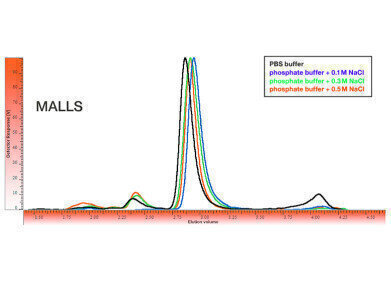-
 Pic 1: SEC in combination with MALLS can provide additional information, especially about the aggregation of a MAb.
Pic 1: SEC in combination with MALLS can provide additional information, especially about the aggregation of a MAb. -
 Pic 2: Chromatograms of Bevacizumab using different eluents using MALLS detection (90° angle). Black: PBS buffer; blue: phosphate buffer + 0.1 M NaCl; green: phosphate buffer + 0.3 M NaCl; red: phosphate buffer + 0.5 M NaCl.
Pic 2: Chromatograms of Bevacizumab using different eluents using MALLS detection (90° angle). Black: PBS buffer; blue: phosphate buffer + 0.1 M NaCl; green: phosphate buffer + 0.3 M NaCl; red: phosphate buffer + 0.5 M NaCl.
Bioanalytical
Analysis of Bevacizumab (Avastin) by SEC-MALLS
Apr 27 2021
Size exclusion chromatography (SEC) is a standard technique for analysing monoclonal antibodies (MAbs) such as Bevacizumab (Avastin®). It is also a standard separation mode used in quality control to obtain information about aggregation and/or fragmentation of the MAb. Detection by light scattering, e.g. multi-angle laser light scattering (MALLS), can provide additional information, as the signal intensity is also influenced by the molar mass in contrast to usual concentration detectors such as UV or RI.
In this application note YMC’s dedicated SEC column for antibodies, YMC-SEC MAB, has been used to develop a method for Bevacizumab using MALLS detection. Four different buffers, a phosphate buffered saline (PBS; containing 0.138 M NaCl, 0.027 M KCl) pH 7.4 and phosphate buffers pH 6.6 (Sigma-Aldrich, 0.034 M) with varying concentrations of NaCl (0.1, 0.3 and 0.5 M), were used.
A defined minimum ionic strength is necessary to achieve a robust method with good resolution, which is not fulfilled by the use of phosphate buffer with 0.1 M NaCl. On the other hand, no significant difference can be determined between the chromatograms obtained using PBS buffer and phosphate buffer with 0.3 or 0.5 M NaCl. Compared to UV detection, the MALLS signal shows two higher molar mass species, aggregates of Bevacizumab, at about 2.0 mL and 2.3 mL elution volume. In PBS another signal can be detected at about 4.0 mL. Therefore, phosphate buffer with 0.3 M NaCl appeared to be the most suitable eluent and was used for further optimisation.
The injection volume was increased from 10 μL to 25 μL and 50 μL without any significant influence on the resolution being observed. This demonstrates the tolerance of the YMC-SEC MAB phase to larger injection volumes. While a general flow rate of 0.33 mL/min was used, a lower flow rate of 0.165 mL/min was also tested. The reduced flow rate showed no benefit, in terms of an improved resolution. Therefore, the higher flow rate was preferred for a higher sample throughput.
YMC-SEC MAB is a column specially designed for the simultaneous analysis of antibodies, their fragments or aggregates. The column is a silica-based size exclusion chromatography column utilising a dihydroxypropyl stationary phase bonded to a silica gel base, specifically designed for antibody separations.
This material offers a 250 Å pore size in 3 µm particle size, making it an excellent choice for separating aggregates from monomer, as well as effectively resolving lower molecular weight fragments. YMC-SEC MAB exhibits excellent resolution and peak shape over a wide molecular weight range of 10 kDa to 700 kDa. Of course, YMC-SEC MAB ensures excellent lot-to-lot reproducibility, which is ideal for quality control.
Digital Edition
Chromatography Today - Buyers' Guide 2022
October 2023
In This Edition Modern & Practical Applications - Accelerating ADC Development with Mass Spectrometry - Implementing High-Resolution Ion Mobility into Peptide Mapping Workflows Chromatogr...
View all digital editions
Events
Apr 23 2024 Kintex, South Korea
Apr 23 2024 Seoul, South Korea
Apr 28 2024 Montreal, Quebec, Canada
May 05 2024 Seville, Spain
May 15 2024 Birmingham, UK













